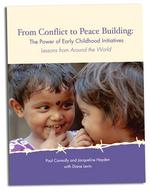ExchangeEveryDay Past Issues
 << Previous Issue
| View Past Issues | | Next Issue >>
<< Previous Issue
| View Past Issues | | Next Issue >> -Persian Proverb
Marjorie Kostelnik, early childhood professor at the University of Nebraska, had a recent discussion with her students about what they thought the early childhood community could do about "the children at the border." Here is her report of the conversation:
"They thought a statement from NAEYC was important — a way to be on the record as 'Standing Up for Children.' However, they also wanted us all to be more proactive and to include their generation in the process. They noted that over the past several days the airwaves and digital news images have been full of anger, fear, and hate. What they wanted was to create an alternate perspective of acceptance, love, and tolerance. Their suggestion was to create a Pinterest site of 'Faces of Love' or 'Faces of Caring' showing the proactive things people are doing to support these children and others who come to the U.S. as 'refugees.'
"For example, our state has taken in 200 children over the past few months quietly — that was a positive act. Just next door in Iowa, communities are gathering now to discuss ways to help. The students wondered how other states and communities are reacting and if NAEYC couldn’t coordinate a site illustrating positive actions as models for others to consider. I am sharing this with you because I was struck by the active nature of their ideas and by their desire to be involved in some way — I wanted you to know we have some innovative leaders coming along."





Comments (9)
Displaying 5 of 9 Comments [ View all ]United States
We often overlook our upcoming leaders in the EC field. Bravo to you for asking them and for sharing.
United States
The positive approach is welcomed and encouraging. However, I also agree with Wendy, this is a long term problem. We need to look at why these children are fleeing their homes. Perhaps it calls for a discussion with authorities of their countries, to examine why it is acceptable and necessary for young children and young adults to flee their homes. Something is very wrong, and the problem is not with the children themselves.
Consultant
Sacramento, Ca, United States
Thank you for this morning's Exchange article. I have felt so distressed by the reported responses to the children coming over the border. I love the pro active responses of the students in Nebraska, particularly the social media posting of positive responses to the children. You are right...I look forward to working with these new leaders! Oh and I do believe NAEYC has issued a statement about the children. Thank you for my daily fix!
College of the Desert
La Quinta, Ca, United States
Certainly i appreciate helping studdnts develop compassion and i believe every American is concerned about these children's well-being. Hopefully, though, as college educators we also challenge students with the complexity of this problem. The immediate solution is compassion and caring for these children. The long term solution---if it were easy, we would already have a national legislation-- makes students think and problem solve more deeply. What is the long-range plan? What about the next 40,000 children? Is there a limit to what the USA can accept before communities can no longer meet the children's needs? Is there a reason, then, to accept children living in poverty all over the world? What kind of national policy or action would help the rest of the families still in Central America? How do we accept children without endorsing the often violent and inhumane "coyote"process? Is it sound child development process to separate children from their parents---this is a difficult conversation related to international adoption in general.
In no way am i against providing the best care for children, especially refuges, but what we are promoting here is putting a bandaid on a critical international problem that will only increase if we do not promote fair and reasonable immigration and international aid.
NE, United States
It warms my heart to hear the caring shown by these students, especially in my state. It is in such amazing contrast to what we hear on the news.
Post a Comment